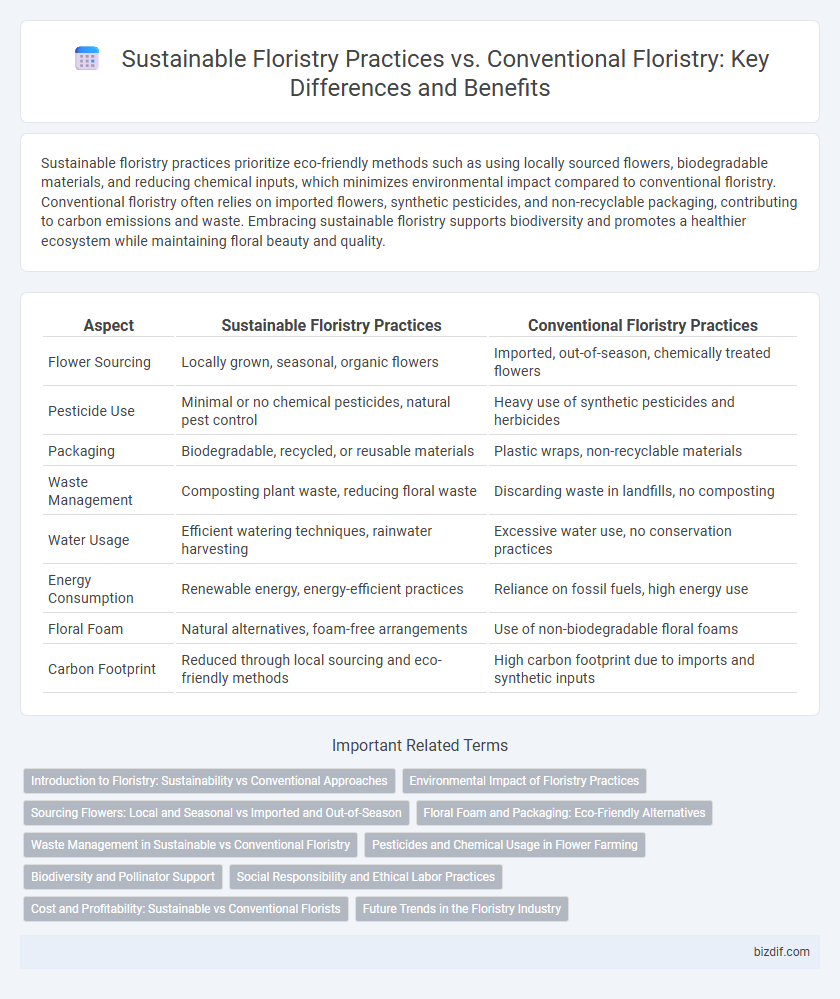Sustainable floristry practices prioritize eco-friendly methods such as using locally sourced flowers, biodegradable materials, and reducing chemical inputs, which minimizes environmental impact compared to conventional floristry. Conventional floristry often relies on imported flowers, synthetic pesticides, and non-recyclable packaging, contributing to carbon emissions and waste. Embracing sustainable floristry supports biodiversity and promotes a healthier ecosystem while maintaining floral beauty and quality.
Table of Comparison
| Aspect | Sustainable Floristry Practices | Conventional Floristry Practices |
|---|---|---|
| Flower Sourcing | Locally grown, seasonal, organic flowers | Imported, out-of-season, chemically treated flowers |
| Pesticide Use | Minimal or no chemical pesticides, natural pest control | Heavy use of synthetic pesticides and herbicides |
| Packaging | Biodegradable, recycled, or reusable materials | Plastic wraps, non-recyclable materials |
| Waste Management | Composting plant waste, reducing floral waste | Discarding waste in landfills, no composting |
| Water Usage | Efficient watering techniques, rainwater harvesting | Excessive water use, no conservation practices |
| Energy Consumption | Renewable energy, energy-efficient practices | Reliance on fossil fuels, high energy use |
| Floral Foam | Natural alternatives, foam-free arrangements | Use of non-biodegradable floral foams |
| Carbon Footprint | Reduced through local sourcing and eco-friendly methods | High carbon footprint due to imports and synthetic inputs |
Introduction to Floristry: Sustainability vs Conventional Approaches
Sustainable floristry practices emphasize using locally sourced, seasonal flowers to minimize carbon footprint and reduce environmental impact, contrasting with conventional floristry that often relies on out-of-season imports and synthetic materials. Eco-friendly techniques include composting floral waste, avoiding chemical pesticides, and promoting biodiversity by incorporating native plant species. These sustainable methods support long-term ecological balance and appeal to environmentally conscious consumers, reshaping the floristry industry's approach to design and supply chain management.
Environmental Impact of Floristry Practices
Sustainable floristry practices prioritize eco-friendly cultivation methods, such as organic farming, reduced pesticide use, and local flower sourcing, which significantly lower carbon footprints and minimize chemical pollution compared to conventional floristry. Conventional floristry often relies on imported flowers transported via air freight, leading to higher greenhouse gas emissions and excessive water usage from intensive farming techniques. Emphasizing biodegradable floral foam, reusable materials, and waste reduction, sustainable floristry greatly mitigates environmental degradation and promotes biodiversity conservation.
Sourcing Flowers: Local and Seasonal vs Imported and Out-of-Season
Sustainable floristry prioritizes sourcing flowers locally and seasonally, reducing carbon emissions and supporting regional ecosystems by minimizing transportation distances and avoiding harmful pesticides. Conventional floristry often relies on imported and out-of-season flowers, contributing to higher environmental footprints due to long-distance shipping and cold storage requirements. Emphasizing local and seasonal blooms enhances biodiversity, promotes fair labor practices, and aligns floristry with eco-friendly principles.
Floral Foam and Packaging: Eco-Friendly Alternatives
Sustainable floristry practices prioritize the use of biodegradable floral foam alternatives made from natural materials like agar or cellulose, which decompose without releasing harmful toxins, unlike conventional floral foam that contributes to plastic pollution. Eco-friendly packaging options such as recycled kraft paper, burlap wraps, and reusable containers reduce waste and environmental impact compared to traditional single-use plastics and non-recyclable wraps. These sustainable choices support a greener floral industry by minimizing waste, promoting compostability, and conserving natural resources.
Waste Management in Sustainable vs Conventional Floristry
Sustainable floristry prioritizes waste reduction through composting organic materials and recycling floral foam alternatives, significantly lowering landfill contributions compared to conventional floristry, which often relies on non-biodegradable floral foam and plastic wraps. Conventional florists generate higher volumes of floral waste due to mass production and frequent disposal of synthetic materials, increasing environmental impact. Implementing sustainable waste management practices enhances resource efficiency and supports circular economy principles within the floristry industry.
Pesticides and Chemical Usage in Flower Farming
Sustainable floristry practices minimize or eliminate the use of harmful pesticides and chemicals, favoring organic fertilizers and natural pest control methods that protect soil health and biodiversity. Conventional floristry often relies on synthetic pesticides and chemical treatments that can lead to soil degradation, water contamination, and harm to pollinators. Emphasizing eco-friendly alternatives in flower farming reduces environmental impact and supports long-term agricultural sustainability.
Biodiversity and Pollinator Support
Sustainable floristry prioritizes the use of locally sourced, native plants that enhance biodiversity and provide vital habitats for pollinators such as bees and butterflies. Conventional floristry often relies on imported, chemically treated flowers that can disrupt local ecosystems and reduce pollinator populations. Emphasizing organic growing methods and diverse plant selections, sustainable floristry actively supports pollinator health and ecosystem resilience.
Social Responsibility and Ethical Labor Practices
Sustainable floristry prioritizes social responsibility by ensuring fair wages, safe working conditions, and support for local communities, contrasting with conventional floristry which often overlooks these ethical labor practices. Certified sustainable flowers and transparent supply chains highlight commitment to worker rights and environmental stewardship. Embracing sustainable floristry fosters ethical sourcing and reduces exploitation in the global flower industry.
Cost and Profitability: Sustainable vs Conventional Florists
Sustainable floristry practices often reduce costs by utilizing locally sourced, seasonal flowers that require less transportation and chemical inputs, lowering overhead expenses compared to conventional floristry's reliance on imported and chemically treated blooms. These eco-friendly methods can enhance profitability through rising consumer demand for ethical products and the potential for premium pricing on sustainably arranged bouquets. Conventional florists may face higher costs linked to supply chain complexity and environmental compliance yet benefit from established supplier relationships and volume discounts.
Future Trends in the Floristry Industry
Sustainable floristry practices leverage locally sourced, seasonal flowers and biodegradable materials to minimize environmental impact, contrasting with conventional floristry's reliance on imported blooms and synthetic preservatives. Future trends in the floristry industry emphasize eco-friendly innovations such as zero-waste arrangements, renewable packaging, and carbon-neutral supply chains. Rising consumer demand for ethical sourcing and climate-conscious products is driving florists to adopt greener methods and transparent sustainability certifications.
Sustainable floristry practices vs conventional floristry practices Infographic

 bizdif.com
bizdif.com